MP8
| Location: Yarto | Northcote Factual Key: Dr 2.13 |
| General Landscape Description: : Flat lake bed of a lake-lunette unit. | Australian Soil Classification: |
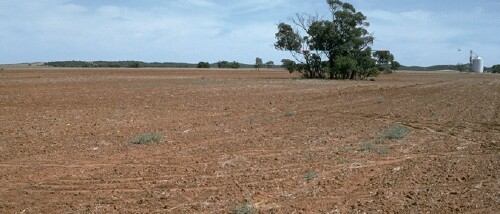 MP8 Landscape |
Soil Profile Morphology:
Surface Soil
| A1 | 0-15 cm | Strong brown (7.5YR4/6); clay loam; hardsetting surface condition; weak blocky structure; firm consistence moist; moderately calcareous; pH 8.4; sharp and smooth change to: | 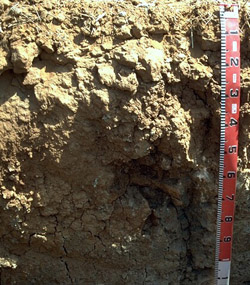 MP8 Profile |
| Subsoil | |||
| B21 | 15-40 cm | Dark reddish brown (5YR3/4); medium heavy clay; strong coarse prismatic, breaking down to strong medium blocky structure; strong consistence dry; slightly calcareous; pH 8.6; diffuse and smooth change to: | |
| B22k | 40-65 cm | Yellowish red (5YR4/6); medium heavy clay; moderate prismatic structure; strong consistence dry; contains a common (10-20%) amount of soft carbonate; very highly calcareous; pH 9.2; diffuse change to: | |
| B31 | 65-100 cm | Grey (10YR6/1) with strong brown (7.5YR4/6) mottles; heavy clay; strong coarse prismatic structure; strong consistence dry; highly calcareous; pH 9.0; diffuse change to: | |
| B32 | 100+ cm | Light brownish grey (2.5Y6/2) with brownish yellow (10YR6/8) mottles; heavy clay; strong prismatic, breaking down to strong coarse blocky structure; strong consistence dry; slightly calcareous; pH 7.7. | |
Key Profile Features:
- Strong texture contrast between surface (A) horizons and subsoil (B21) horizon.
- Hardsetting surface soil with high fine sand content (34%).
- Moderate to strong alkaline profile.
- Subsoil sodicity becoming strong at 40 cm depth.
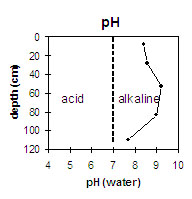 | 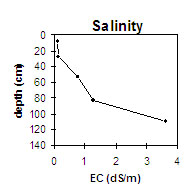 |
| The surface soil is moderately alkaline. The subsoil is strongly alkaline. | The salinity rating is low in the surface soil and increases to a high rating in the deeper subsoil. |
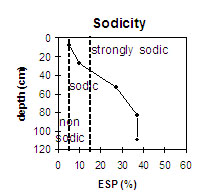 | 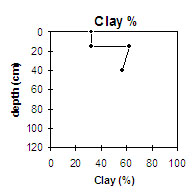 |
| The surface soil is non-sodic. The upper subsoil is sodic and becomes strongly sodic at 40 cm. | The clay content increases abruptly at the interface between the surface and subsoil. |
Management Considerations:
Surface (A) Horizons
- The surface soil has a high fine sand content (ie. 34%) and is hardsetting when dry. Soils such as these rely to a large extent on organic matter for maintaining aggregation. The levels of organic carbon measured at the pit site (which may or may not be representative of the whole paddock) is low. Organic matter will build up under pasture but will decline if cultivation takes place. Practices such as residue retention, minimum tillage and including pasture rotations could be utilised if cropping takes place in order to build up organic matter and the soils low inherent fertility.
- The levels of total nitrogen measured at this pit site is moderate which is very good for this region. However, this is best assessed by taking a bulked sample from across the paddock.
- Although the surface soil is non-sodic it has a rating of 5 which is very close to sodic and has a low exchangeable calcium to magnesium ratio (ie. 0.9). The presence of moderate dispersion after remoulding also indicates that structural degradation (e.g. surface sealing, increased cloddiness) may occur if the soil is cultivated or overstocked in a moist to wet condition. Also, raindrop action on bare surface soil may also promote dispersion and exacerbate the hardsetting condition. Surface cover should be maintained to protect against raindrop damage. The use of gypsum may assist in ameliorating the surface soil and decreasing the hardsetting condition.
Subsoil (B) Horizons
- The subsoil has a high inherent fertility throughout as well as high calcium which has a beneficial effect on soil structure and increases available plant nutrients.
- The strongly alkaline subsoil suggests that some nutrients (e.g. manganese, zinc, iron, copper) may be poorly available to plants. Deep ripping and gypsum application may help alleviate this problem.
- The coarsely structured subsoil below 40 cm depth becomes strongly sodic. Moderate dispersion occurs as a result restricting root and water movement, however, with the increase of salt levels going down the profile the dispersion decreases slightly.
- The salinity rating becomes moderate at about 60 cm depth and increases to a high level at about 80 cm. These levels of soluble salts are likely to restrict the growth of salt sensitive plant species (e.g. faba beans, linseed, chickpeas and lupins).
- The high level of exchangeable sodium and magnesium in the deeper subsoil may also result in nutrient imbalances and may also have a toxic effect on some plants.
Profile Described By: Mark Imhof, Jim Rowan and Sonia Thompson (March 1994).


